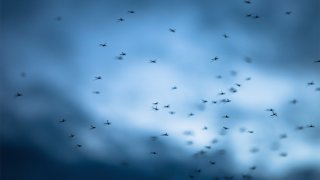
Battling the winged beasts before modern methods wasn’t easy. Desperate early Floridians tried everything, from slathering their bodies in lumps of bear fat to burning oily rags. Indigenous people avoided mangrove trees, where mosquitoes breed in the summertime, and used nets to cover up. Spaniards hid from the hungry skeeters under their armor as they trudged through the marshes.
That was just the beginning.
A missionary sent to the Biscayne Bay area in the 1580s provided early evidence of the itchy hellscape that was early Florida.
“He wrote back to his father superior that he would do anything to get out of this pestiferous place,” said Gordon Patterson, a professor at the Florida Institute of Technology and an expert on the history of mosquitoes in Florida. “‘Give me thieves, scoundrels, murderers, but these mosquitoes are are more than I can tolerate.'"
Jonathan Dickinson was shipwrecked near Jupiter in the 1600s, Patterson said. A book of his account describes the native people surrounding themselves in clouds of smoke and burying themselves in the sand for protection. His journals lamented about hard nights trying to sleep among the biting.
The creatures weren’t just annoying — they were deadly.
“Hordes of mosquitoes suffocated cattle and drove humans to suicide,” reads the forward of Patterson’s book, The Mosquito Wars.
Local
Dengue and yellow fever epidemics slammed Florida in the 1700s. In the last 20 years of the century, disease-harboring mosquitoes killed more human beings than any other animal on this planet, Patterson said.
Yellow fever caused so many to fall ill or die that in 1888 the State Board of Health was formed a year later. The board’s first leader? An expert in mosquitoes.
Floridians tried to hide from mosquitoes at night to avoid diseases. According to Times archives, draining projects and the building boom of the 1920s helped to reduce mosquitoes, especially in Pinellas.
“During this century, developers have destroyed 45 percent of the mangroves that once lined Tampa Bay and more than 75 percent of the forest,” wrote Jeff Klinkenberg for the then-St. Petersburg Times in 1989. “The result is less wildlife and fish, but the silver lining is fewer mosquitoes.”
The Florida Anti-Mosquito Association (now known as the Florida Mosquito Control Association) was formed in the early 1920s. The location of the first meeting: Indian River County, then called Mosquito County.
Florida’s salt marshes were fantastic breeding grounds for two types of mosquitoes. One of the worst places in the state —if not the planet — was Sanibel Island.
“Among entomologists, Sanibel was renowned as ‘the world’s greatest pest hellhole.’” Patterson wrote in Mosquito Wars. “Longtime Sanibel residents were accustomed to seeing Pat Murphy, the island’s mailman, driving his route in the hottest summer months 'wrapped in Eskimo clothing and netting.”
Mosquito control ramped up in the 1940s, Patterson said. The USDA set up a “quasi-secret” laboratory on Paramour Street in Orlando, where researchers experimented with new insecticides that would protect the Allied troops fighting in malaria-rich areas. The lab still exists today, but is located in Gainesville.
Shortly after this time, mass spraying of the chemical DDT took off in thousands of homes.
According to Mosquito Wars, the United States Public Health Service even hired Walt Disney’s artists to spread the word about malaria and mosquito defenses. One cartoon featured the seven dwarves as mosquito workers who sprayed the chemical. “The Winged Scourge” played in movie theaters across the state ahead of the main show.
Around this time in Tampa, Boy Scouts led marches and launched educational mosquito control campaigns. Children policed the streets to drain empty cans and other collectors of still water.
“Schoolchildren in Tampa put on plays where they dressed up like mosquitoes,” Patterson said. “Tampa played a major role in that story.”
The United States Office of Malaria Control in War Areas and United States Public Health Service even produced a short film in 1945 showing the scouts trying to prevent dengue and yellow fever around the city.
Mosquitoes were still so bad on the space coast that they held up rocket launches at the Kennedy Space Center in the ’50s.
A special sub-committee was created to figure out a mosquito solution. The mosquito impoundments that were created later were distributed across the state.
“If it hadn’t been for mosquito control,” Florida’s state entomologist Jack Rogers said, “I don’t know how the space program would have gotten off the ground.”
Mosquito research has taught us a lot. We know that only the egg-laying females bite us, and that pests are drawn to us because of the carbon dioxide in our breath, lactic acid coming off our skin and the dirty odor of our feet. We also know that women, tall people, and folks wearing dark clothing are more likely to be bit.
Modern mosquito control has come a long way, too. DDT, later found to cause harm to the environment, wildlife and even potentially humans, was banned.
There are now over 50 mosquito control agencies across Florida.



